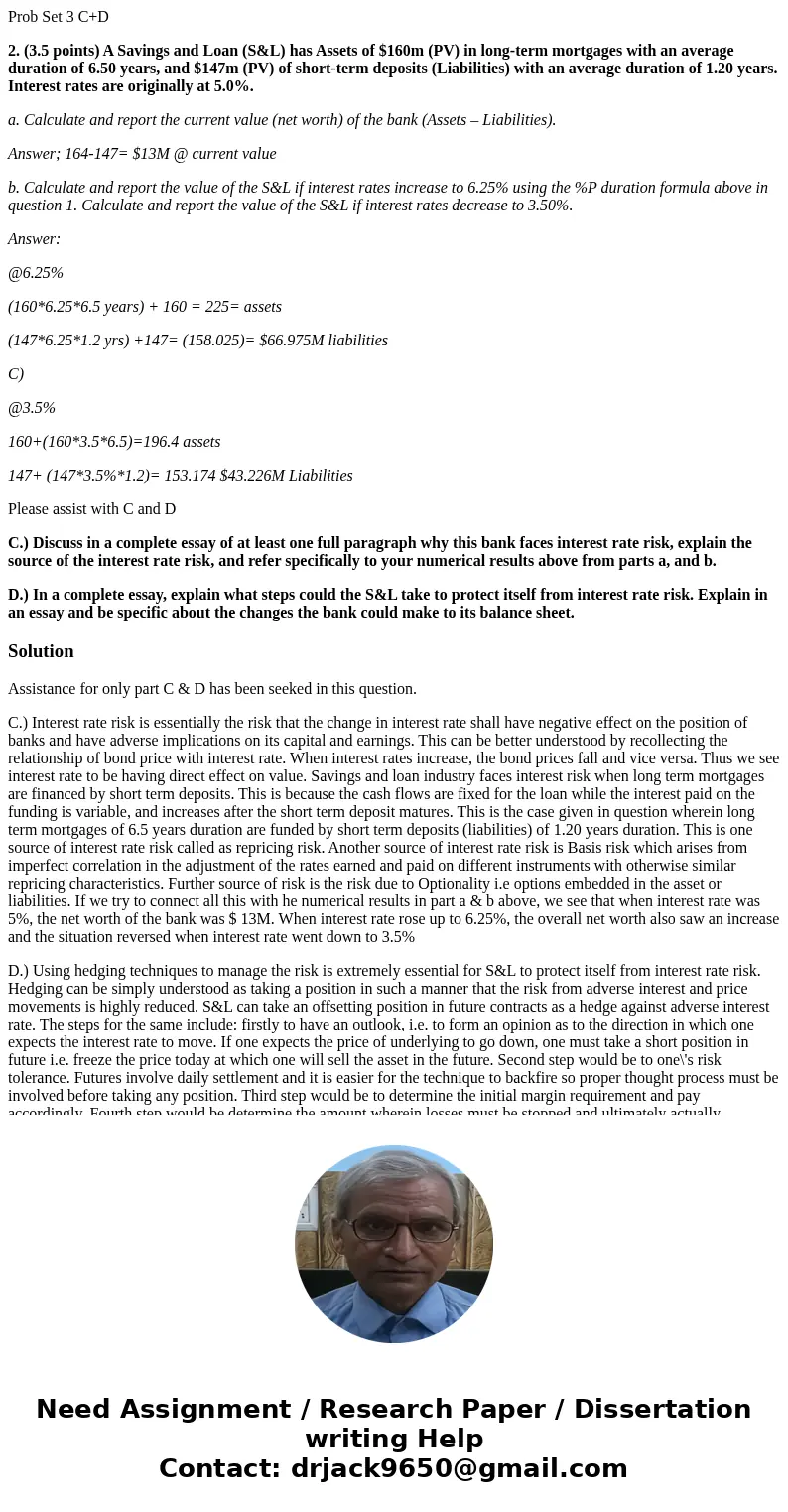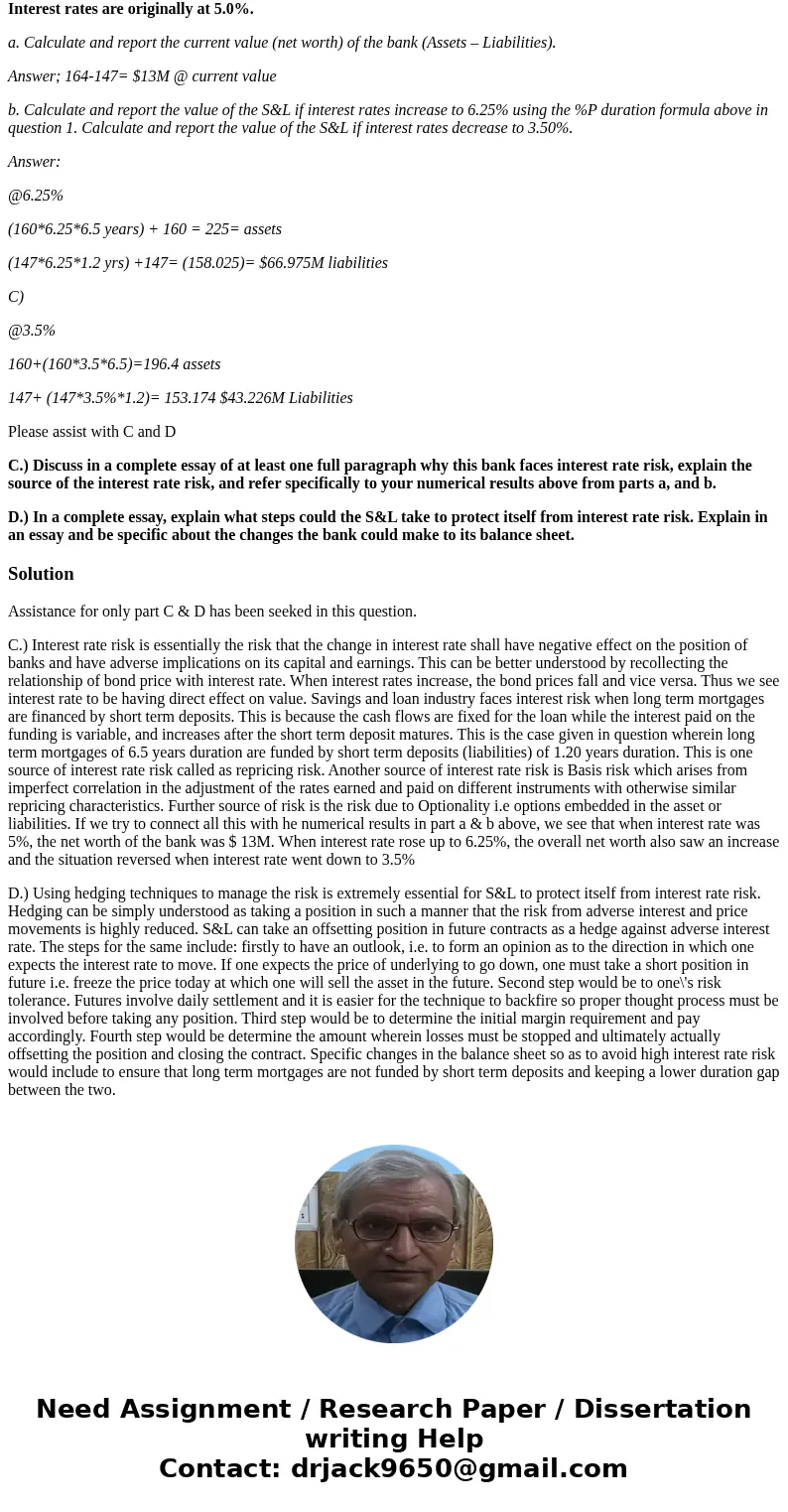Prob Set 3 CD 2 35 points A Savings and Loan SL has Assets o
Prob Set 3 C+D
2. (3.5 points) A Savings and Loan (S&L) has Assets of $160m (PV) in long-term mortgages with an average duration of 6.50 years, and $147m (PV) of short-term deposits (Liabilities) with an average duration of 1.20 years. Interest rates are originally at 5.0%.
a. Calculate and report the current value (net worth) of the bank (Assets – Liabilities).
Answer; 164-147= $13M @ current value
b. Calculate and report the value of the S&L if interest rates increase to 6.25% using the %P duration formula above in question 1. Calculate and report the value of the S&L if interest rates decrease to 3.50%.
Answer:
@6.25%
(160*6.25*6.5 years) + 160 = 225= assets
(147*6.25*1.2 yrs) +147= (158.025)= $66.975M liabilities
C)
@3.5%
160+(160*3.5*6.5)=196.4 assets
147+ (147*3.5%*1.2)= 153.174 $43.226M Liabilities
Please assist with C and D
C.) Discuss in a complete essay of at least one full paragraph why this bank faces interest rate risk, explain the source of the interest rate risk, and refer specifically to your numerical results above from parts a, and b.
D.) In a complete essay, explain what steps could the S&L take to protect itself from interest rate risk. Explain in an essay and be specific about the changes the bank could make to its balance sheet.
Solution
Assistance for only part C & D has been seeked in this question.
C.) Interest rate risk is essentially the risk that the change in interest rate shall have negative effect on the position of banks and have adverse implications on its capital and earnings. This can be better understood by recollecting the relationship of bond price with interest rate. When interest rates increase, the bond prices fall and vice versa. Thus we see interest rate to be having direct effect on value. Savings and loan industry faces interest risk when long term mortgages are financed by short term deposits. This is because the cash flows are fixed for the loan while the interest paid on the funding is variable, and increases after the short term deposit matures. This is the case given in question wherein long term mortgages of 6.5 years duration are funded by short term deposits (liabilities) of 1.20 years duration. This is one source of interest rate risk called as repricing risk. Another source of interest rate risk is Basis risk which arises from imperfect correlation in the adjustment of the rates earned and paid on different instruments with otherwise similar repricing characteristics. Further source of risk is the risk due to Optionality i.e options embedded in the asset or liabilities. If we try to connect all this with he numerical results in part a & b above, we see that when interest rate was 5%, the net worth of the bank was $ 13M. When interest rate rose up to 6.25%, the overall net worth also saw an increase and the situation reversed when interest rate went down to 3.5%
D.) Using hedging techniques to manage the risk is extremely essential for S&L to protect itself from interest rate risk. Hedging can be simply understood as taking a position in such a manner that the risk from adverse interest and price movements is highly reduced. S&L can take an offsetting position in future contracts as a hedge against adverse interest rate. The steps for the same include: firstly to have an outlook, i.e. to form an opinion as to the direction in which one expects the interest rate to move. If one expects the price of underlying to go down, one must take a short position in future i.e. freeze the price today at which one will sell the asset in the future. Second step would be to one\'s risk tolerance. Futures involve daily settlement and it is easier for the technique to backfire so proper thought process must be involved before taking any position. Third step would be to determine the initial margin requirement and pay accordingly. Fourth step would be determine the amount wherein losses must be stopped and ultimately actually offsetting the position and closing the contract. Specific changes in the balance sheet so as to avoid high interest rate risk would include to ensure that long term mortgages are not funded by short term deposits and keeping a lower duration gap between the two.


 Homework Sourse
Homework Sourse